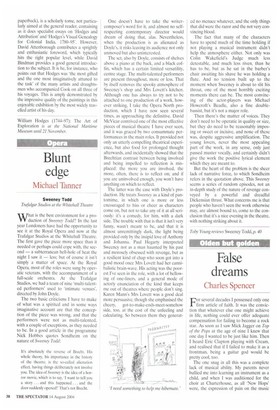Blunt edge
Michael Tanner
Sweeney Todd
Trafalgar Studios at the Whitehall Theatre
what is the best environment for a production of Sweeney Todd? In the last year Londoners have had the opportunity to see it at the Royal Opera and now at the Trafalgar Studios at the Whitehall Theatre. The first gave the piece more space than it needed or perhaps could cope with, the second — a subterranean hell-hole of heat the night I saw it — less; but of course it isn't simply a matter of space. At the Royal Opera, most of the roles were sung by operatic veterans, with the accompaniment of a full-scale orchestra. At the Trafalgar Studios, we had a team of nine 'multi-talented performers' used to 'intimate venues', directed by John Doyle.
The two basic criticisms I have to make of what was a spirited and in some ways imaginative account are that the conception of the piece was wrong, and that the performers were not as multi-talented, with a couple of exceptions, as they needed to be. In a good article in the programme Nick Hobbes quotes Sondheim on the nature of Sweeney Todd:
It's absolutely the reverse of Brecht. His whole theory, his importance in the history of the theatre, is the so-called alienation effect, having things deliberately not involve you. The idea of Sweeney is the idea of a horror movie, which is to say, 'I want to tell you a story. . and this happened. .. and the door suddenly opened!' That's not Brecht.
One doesn't have to take the writercomposer's word for it, and almost no selfrespecting contemporary director would dream of doing that, alas. Nevertheless, when the production is as alienated as Doyle's, it risks leaving its audience not only unmoved but also uninterested.
The set, also by Doyle, consists of shelves above a piano at the back, and a black coffin, which has a certain limited versatility, centre stage. The multi-talented performers are present throughout, more or less. That by itself removes the spooky atmosphere of Sweeney's shop and Mrs Lovett's kitchen. Although one has always to try not to be attached to one production of a work, however striking, I take the Opera North production, which I have now seen several times, as approaching the definitive. David Mc Vicar contrived one of the most effective pieces of musical theatre I have ever seen, and it was graced by two consummate performances in the main roles. It provided not only an utterly compelling theatrical experience, but also food for prolonged thought afterwards, and incidentally showed that the Brechtian contrast between being involved and being impelled to reflection is misplaced: the more you are involved, the more, often, there is to reflect on; and if you are uninvolved enough, you won't have anything on which to reflect.
The latter was the case with Doyle's production. He treats Sweeney as a kind of pantomime, in which one is more or less encouraged to hiss or cheer as characters come on, but not to take any of it at all seriously: it's a comedy, for him, with a dark side. The trouble with that is that it isn't very funny, wasn't meant to be, and that it is almost unremittingly dark, the light being provided only by the insipid love of Anthony and Johanna. Paul Hegarty interpreted Sweeney not as a man haunted by his past and morosely obsessed with revenge, but as a resilient kind of chap who soon got into a good mood once Mrs Lovett had her cannibalistic brain-wave. His acting was the poorest I've seen in the role, with a lot of bellowing of one-liners, and a general mode of actorly enunciation of the kind that keeps me out of theatres where people don't sing. Karen Mann's Mrs Lovett was a good deal more persuasive, though she emphasised the cheery, got-to-make-ends-meet-somehow side, too, at the cost of the unfeeling and calculating. So between them they generat ed no menace whatever, and the only things that did were the razor and the not very convincing blood.
The fact that many of the characters have to spend much of the time holding if not playing a musical instrument didn't help the atmosphere either. Not only was Colin Wakefield's Judge much less detestable, and much less riven, than he has to be, but as he sat in the barber's chair awaiting his shave he was holding a flute. And no tension built up to the moment when Sweeney is about to slit his throat, one of the most horribly exciting moments there can be. The most convincing of the actor-players was Michael Howcroft's Beadle, also a fine doublebassist, but it's not a major role.
Then there's the matter of voices. They don't need to be operatic in quality or size, but they do need to be reasonably imposing or sweet or incisive, and none of these was, despite aggressive amplification. The young lovers, never the most appealing part of the work, in any sense, only just passed muster vocally, and certainly didn't give the work the positive lyrical element which they are meant to.
But the heart of the problem is the sheer lack of narrative force, to which Sondheim refers in the quotation above. This Sweeney seems a series of random episodes, not an in-depth study of the nature of revenge conveyed by a powerful and dreadful Dickensian thrust. What concerns me is that people who haven't seen the work otherwise may, are almost bound to, come to the conclusion that it's a nice evening in the theatre, with nothing striking about it.
Toby Young reviews Sweeney Todd, p. 40


























































 Previous page
Previous page